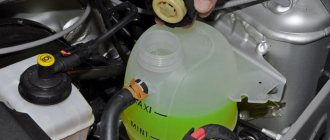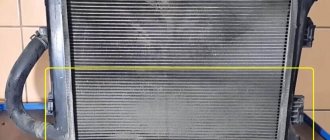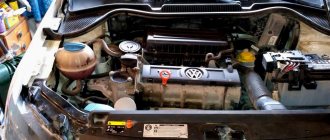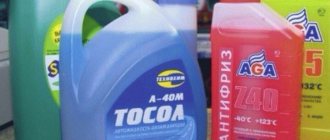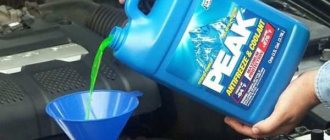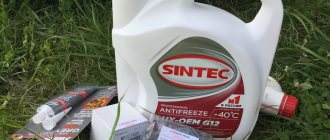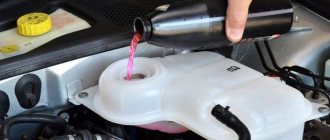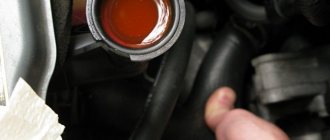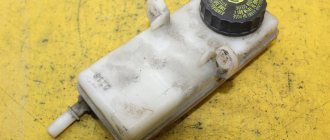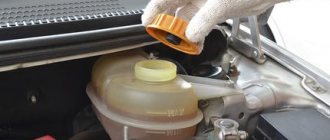Replacing Kia Rio 3 antifreeze is carried out during the eighth maintenance (at around 120 thousand km), but if its properties are lost, it may be needed earlier.
The Kia Rio 3 thermostat is replaced if the unit breaks down. How to find out about this, how to properly replace consumables? We will talk about this in the material.
Signs of lost coolant properties
Green antifreeze for Kia Rio 3
The need to replace the coolant in the Kia Rio 3 before the scheduled deadlines can be indicated by:
- a change in the original color of the antifreeze (for example, a brownish tint will indicate corrosion processes);
- the appearance of turbidity (this sign indicates stratification of antifreeze, sedimentation in the cooling system);
- loss of initial density (externally, i.e. without a hydrometer, this sign cannot be detected).
The Kia Rio 3 maintenance schedule with consumables articles is described in detail in this material.
Materials and tools for work
- Consider the size of the drain container - approximately 6 liters (in this case, an old canister is perfect for draining).
- Also bring a funnel with you (a funnel made from an old plastic bottle works great).
- A rubber bulb or a large probe or syringe for pumping out the mixture (required for pumping out antifreeze from the expansion tank).
- You will also need pliers to open the cooling system.
- Replacement should only be carried out with the engine turned off and already cooled down.
Signs of a failed thermostat
An inspection of the car's cooling circuit is carried out when there is a suspicion that the Kia Rio 3 thermostat has stopped working. Signs:
Thermostat
- after starting, the engine reaches operating temperature with a significant delay;
- engine overheating;
- the movement of the arrow in the direction of decreasing temperature begins at a lower speed of the car, and after stopping the engine the temperature increases;
- the pipe located at the bottom heats up almost immediately after start-up, which indicates an open thermostat;
- the lower pipe is cold, although the coolant temperature is close to boiling (if we exclude the possibility of a faulty fan sensor).
The question of replacing the Kia Rio 3 thermostat is raised if at least one sign is detected.
Texts about maintenance and repair of Kia Rio 3 in this section.
Let's sum it up
Only by paying close attention to such a capricious system as cooling can you ensure the proper functioning of the KIA Rio 3 engine without the risk of overheating. This measure will also make it possible to constantly provide the interior with a warm air flow in winter.
Sources
- https://tuning-mg.ru/dvigateli/zamena-ohlazhdayushchej-zhidkosti-kia-rio-2.html
- https://cooptech.ru/dvizhok/zamena-antifreeza-kia-rio-1.html
- https://libratex.ru/stati/kak-dolit-antifriz-v-kia-rio.html
- https://novoe-info.ru/kuda-zalivat-ozh-v-kia-rio-3/
- https://kianova.ru/kak-dolit-antifriz-v-kia-rio-avto-remont
- https://kianova.ru/kak-zamenit-okhlazhdayushchuyu-zhidkost-v-kia-rio-3
- https://AutoZaliv.ru/service/zamena-antifreeze/pomenyat-antifriz-kia-rio
- https://etlib.ru/report/1435-zamena-antifreeza-kia-rio-3
- https://remont-inomarki.ru/zamena-antifriza-na-kia-rio.html
- https://SpecTorg.su/tehobsluzhivanie/zamena-antifriza-kia-rio-3.html
- https://razborov.net/kia/osobennosti-zameny-ohlazhdayuschey-zhidkosti-v-avtomobile-kia-rio-3.html
- https://24kia.net/rio/dvigatel-i-korobka/antifriz.html
Cooling system Kia Rio
1 - outlet pipe, 2 - pump pulley, 3 - thermostat cover, 4 - pipe between the expansion tank and the filler neck, 5 - filler cap, 6 - inlet pipe, 7 - radiator, 8 - tank Temperature
conditions of the internal combustion engine on Kia Rio cars Generation 3 is ensured by the operation of the following elements:
- radiator;
- fan with power supply;
- pump pumping antifreeze;
- thermostat.
The coolant is distilled through hoses; the engine itself has a cooling jacket. Filling is carried out through the expansion tank and the radiator cap.
The Kia Rio 3 thermostat performs a measuring function; at around 80 degrees the circulation valve opens. Full opening is provided at 95 degrees.
This is what the Kia Rio 3 thermostat housing looks like
In Kia Rio, the volume of coolant depends on the engine size and the generation of the car. Before you start replacing the contents of the cooling circuit, you need to consider how much antifreeze is in the Kia Rio 3. The total volume is 5.3 liters , used
Green antifreeze for Kia Rio 3
poured into a container prepared in advance, filling is carried out only with fresh liquid with factory specifications.
Review of Kia Rio engines of different generations in this material.
Necessary means at hand
To successfully change used antifreeze in the third-generation cooling system of a Korean Kia car, you may need the following tools:
- a container for draining waste, with a volume of about six liters;
- funnel for directing the flow of antifreeze;
- a rubber bulb or volumetric syringe for extracting waste fluid from the expansion tank;
- pliers or pliers;
- dipstick for checking the antifreeze level;
- dry rags or rags;
- latex gloves.
It is important to remember that the procedure for replacing antifreeze in the system must be performed after the vehicle engine has completely cooled down.
What antifreeze to fill in Kia Rio
The temperature characteristics of the coolant used in the Russian climate are from -40 to +130 degrees. Antifreeze is made on the basis of ethylene glycol, which allows it to be diluted before use. If the coolant contains methanol and glycerin, then the quality of the mixture drops significantly.
Original antifreeze
Service workers servicing 3rd generation Kia Rio cars recommend using antifreeze marked G11 or higher. Mixing liquids from different manufacturers is not allowed, since there is a high probability of sedimentation, foaming and other troubles. Before replacing the contents of the Kia Rio 3 cooling circuit, it makes sense to rinse it with distilled water.
What to fill? How to find out and get a good price?
Below are budget coolants from domestic manufacturers of the G11 class. The largest and most famous companies in Russia.
They are significantly inferior to the original. The service life is 2-3 years. Why are they used? It is difficult for an ordinary owner to understand all the nuances. He has two questions: The color of the liquid and the price. Demand creates supply. You can't go against the consumer.
If you plan to use the car for many years, it is better to use the factory one. It's cheaper at a distance. Moreover, the difference in price is not big.
I don’t write prices, because... they are constantly changing. Use articles and online stores to find out. How to do this, as well as how to find out the price of other antifreezes, see the video at the end of this section. Now let's move on to the manufacturers.
Antifreeze-Sintez, article number for 4.5l canister - 430206222 and 0.9 canister 430206221.
Greencool, number 791661, container 4.5l and 791951 0.9l
Coolstream CS010702GR 4.5l and CS010701GR 0.9
Below is a video that shows how to find the article number of any manufacturer and find out where the best price is.
Your browser does not support the format
What coolant to buy
Before you start replacing the coolant in a Kia Rio 3, it is important to understand what kind of antifreeze is filled in from the factory. When purchasing a car on the secondary market, you should also pay attention to this issue.
Hyundai Long Life Coolant, which comes with catalog number MS-591-08.
It is allowed to fill with Shell Premium antifreeze (a thermally stable blue compound that is neutral to plastic).
Hyundai Long Life Coolant - for Kia Rio
coolant works excellent in cold weather , but can boil already at 109 degrees, which is critical in hot summer conditions. You can fill the Kia Rio 3 cooling circuit with RAVENJL HJC Hybrid Japanese Coolant (Japanese green composition with high compatibility). Another representative of the Japanese market is TCL Power Coolant Green . The temperature range of the composition is from -40 to +110 degrees. Organic antifreeze components do not cause sediment to form. An expensive option is Sintec Unlimited . Judging by the name, the fluid's lifespan inspires confidence, since a car can easily drive on it for 5 years without replacement.
The question of what antifreeze to fill in the Kia Rio 3 is decided by each owner independently.
Replacing antifreeze and thermostat on Kia Rio 3
Filling the Kia Rio 3 circuit with new antifreeze and replacing the thermostat does not require special skills, so you can do everything yourself. The main thing is to follow the instructions. From the tools and available materials you will need:
Filler neck
- container for draining old fluid;
- large volume syringe or syringe with a tube;
- funnel (piece of plastic bottle with a neck);
- pliers;
- rags.
Replacement of antifreeze is carried out on a cooled internal combustion engine.
Draining the old coolant
To drain, you need to place the car on a flat surface and remove the engine protection. The drain plug is located at the bottom of the radiator on the right side. There will be more access if you first remove the air intake, which is held in place by two clips. Place a container under the drain hole. As soon as the antifreeze starts flowing, you need to unscrew the cap at the top of the radiator.
Drainer
The drainage can be slightly enhanced if you remove the lower pipe, since the Kia Rio 3 engine does not have an additional valve for emptying the cooling jacket. Although this procedure will give insignificant results. Antifreeze is sucked out of the tank using a syringe or syringe. Replacement involves completely freeing the system from the old composition, so additional flushing will be required.
Replacing the thermostat Kia Rio 3
If signs of a faulty thermostat are detected, the part must be replaced. The thermostat is attached to the Kia Rio 3 cylinder block with two bolts through the cover; they need to be unscrewed with a “12” head. Next, the thermostat cover slides off the studs; there is no need to disconnect the hose. The device is removed from the block socket. The rubber gasket is removed from the thermostat flange.
Removing the thermostat
You can check the Kia Rio thermostat yourself; to do this, place the device in a transparent container with water (not made of plastic, since it will need to be heated). When heating, the water needs to be stirred.
If the thermostat is faulty, the valve will not move at a temperature of 80-83 degrees and will not open completely at 95 degrees.
If you decide to replace a broken thermostat, then the new part must be installed in the reverse order.
Installing a new thermostat
If only the gasket is changed, then it is necessary to ensure that its protrusion is aligned with the protrusion of the flange. There is a groove in the socket on the Kia Rio cylinder block that you need to get into with the protrusion of the gasket. The bolts securing the thermostat must be tightened in accordance with the instructions (i.e., observe the tightening torque).
Flushing the cooling system
The remnants of antifreeze to be replaced on the Kia Rio 3 are washed out with distilled water.
Rinse with distilled water
Flushing begins by closing the radiator drain hole. Water flows until the Kia Rio 3 radiator is completely filled. Then they proceed to filling the expansion tank for coolant. After this, the plugs are tightened (on the tank and radiator).
Closing the drain hole
The internal combustion engine warms up before the thermostat valve opens, so water fills the entire circuit. The mixing of residual antifreeze with water can be improved if you periodically press the gas pedal during warming up. Hot pipes and a running fan will be a signal that it’s time to turn off the internal combustion engine. Wait for the engine to cool before draining the water.
Warming up the engine
During flushing, you need to control the temperature, since if there is an air lock, the indicators can be deceiving. After the engine has cooled down, flushing should be repeated.
Filling new antifreeze in Kia Rio 3
Having finished washing, they begin to fill the cooling circuit with a new composition. You can use a concentrate, which is diluted according to the instructions. The proportion is calculated taking into account the fact that when drained, about 1.5 liters of water mixed with old antifreeze remains in the system.
Filling with antifreeze
Filling begins with the radiator; the pipes are kneaded to circulate air. Having filled the radiator to the top, go to the expansion tank, while focusing on o.
The internal combustion engine warms up with a short increase in speed, the engine needs to cool down . Coolant is added to the circuit, since during warming up it has completely dispersed through it. This is how antifreeze is replaced on Kia Rio 3.
The order of steps for changing the coolant. mixtures
- To begin with, you should turn the throat cap half a turn, which will make it possible to reduce the pressure in the car system itself and carry out the subsequent steps with greater safety.
- Crawl under your Kio Rio, then unscrew the engine protection and remove the internal shield, which protects the left side of the engine from soot and dirt getting into it.
- Next, simply unscrew the mudguard on the right side of the engine.
- After this, place a canister under the radiator drain to collect the mixture.
- Completely unscrew the drain plug of the engine cooling mechanism.
- Unscrew the top of the filler container.
- Next, you can partially unscrew the plug (if the pressure level drops, then unscrew it entirely).
- After draining the mixture from the radiator, screw everything back in as before.
- Loosen the compression force of the valve on the internal radiator pipe, then unscrew it and drain the remaining mixture from the engine.
- Using a large syringe, you should pump out the old antifreeze from the expansion tank and pour in fresh antifreeze.
- Fill in fresh mixture to cool the engine until the mixture begins to flow into the expansion tank. Next, simply close the lid.
Towards the end of the replacement, it is worth turning on the car’s engine and letting it warm up before the fan starts working (which will make it possible to ensure that all parts in the engine, including its cooling system, are working correctly).
- Check the overall antifreeze level and then bring it to the “F” mark (this means full).
- If a warm air flow does not flow from the internal heater on a heated engine, this may tell us that a water or air lock has appeared in the Rio 3 cooling system.
- After starting the engine, look at the indicator. If the internal indicator moves towards the red area, but the fan does not turn on, you should restart the heater and then check the amount of air. If the air is a little warm, then the fault is hidden in the fan itself, but if it is cool, there is most likely a plug in the cooling mixture.
- Operate your car in simple mode, but still 2-3 days after the replacement, it’s worth looking under the hood of your Rio 3 and checking the amount of mixture.
- About counterfeits - the main evidence of counterfeit antifreeze is its rapid loss of color during operation with deterioration in performance.
